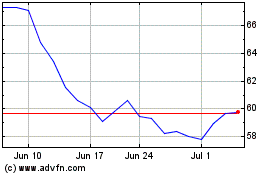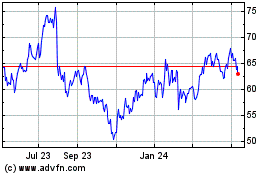By Peter Rudegeair
The lending machines of Silicon Valley are running at
half-speed.
Financial-technology companies including PayPal Holdings Inc.
and Square Inc. were eager to participate in the government's $350
billion lending program designed to keep small businesses afloat
during the coronavirus pandemic. But some aspects of the government
programs render much of the industry less effective.
The stakes are high for small businesses desperate for cash,
especially since the program is close to running out of money.
A new Federal Reserve facility that will finance billions of
dollars of the loans excludes lenders that aren't banks. What's
more, fintech lenders got a late start compared with banks. The
Treasury Department and Small Business Administration didn't start
letting the fintech companies into the first-come, first-served
lending program until after roughly half of the funds had already
been claimed.
And the SBA's loan portal is ill-equipped to plug into the
automated lending software developed by startups and tech
companies. The portal, for example, often requires lenders to
insert applicants' information manually.
"It's kind of like they built a maglev train and had to
reverse-engineer it into a handcar, because that's the track
they've been given," said Brian Peters, executive director of
Financial Innovation Now, an industry association whose members
include Intuit Inc., PayPal and Square.
Fintech companies have ramped up their lending to small
businesses over the past five years, filling a void left by banks
that backed away from the sector following heavy losses during the
financial crisis. For many small businesses, they are the only way
to get a loan. But with the pot of money reserved for payroll loans
running out as soon as this week and with no agreement in Congress
to add more funding, many small businesses, especially those that
were turned away by banks, could be left behind.
"We're doing our best, but the timelines are tight and the
demand is high," said Luke Voiles, vice president and business
leader of Intuit's lending arm, QuickBooks Capital.
The $350 billion recovery effort, called the Paycheck Protection
Program, allows small businesses to apply for forgivable loans that
can be used to cover eight weeks of payroll and other expenses.
Businesses apply to lenders, and the SBA guarantees the loans.
From the start, policy makers wanted to expand the pool of
approved SBA lenders to reach more small businesses, and fintech
companies spotted an opportunity. In mid-March, Square Chief
Executive Jack Dorsey reached out to Treasury Secretary Steven
Mnuchin to express interest in joining the program, according to
people familiar with the matter.
Among the companies that received the go-ahead in recent days to
start making payroll loans were Intuit, PayPal and Square, as well
as the specialized online lenders Funding Circle USA Inc. and On
Deck Capital Inc. But the first of them only got approval a week
after banks started accepting loan applications on April 3.
Fintech companies bring vast customer networks to the table. In
the U.S., PayPal serves more than 10 million small businesses while
Intuit's QuickBooks accounting software counts about six million
users.
Many small businesses have complained that big banks won't even
consider applications from businesses that aren't existing
customers. The ability to apply for a loan through a tech vendor
they use gives them more options.
It also helps that many fintech companies already have vast
amounts of information on their clients, which they say lets them
make lending decisions quickly. Square and Intuit, for example,
also make payroll software for businesses, so they can produce the
documentation themselves for the government-backed loans without
applicants having to calculate anything.
The volume of small loans to businesses on big banks' books fell
more than one-fifth from mid-2015 until mid-2019, according to data
from the Federal Deposit Insurance Corp. During that span, PayPal
expanded its holdings of loans it made to businesses by more than
10-fold, to $2.4 billion.
To receive the government guarantee, loan applications are
submitted through an SBA portal called E-Tran. The bulk of those
often require loan officers to enter applicants' information
manually, according to lenders.
Last fiscal year, about 52,000 loan requests for the SBA's
flagship program were approved through E-Tran, according to the
agency. In just the past two weeks, the SBA has approved more than
one million payroll loans.
Banks resorted to assigning thousands of employees to the task
of filling in fields in E-Tran by hand to handle the flood of
interest in the payroll-loan program. Fintech companies, which
operate with fewer people and more automation, can't easily do the
same.
The SBA is developing an application-programming interface, a
way for two pieces of software to exchange data without human
involvement, for payroll loans that would allow lenders to upload
applications in batches, according to people familiar with the
matter. Certain lenders are testing that interface, but it was
unknown when the SBA would start accepting actual applications
through it, the people said.
How to fund the loans is another challenge for fintech lenders.
Banks can choose to make the loans using their depositors' money or
use the loans as collateral to borrow from the Fed. Fintech
companies, because they aren't banks, can't avail themselves of
either option.
Many fintech lenders rely on outside investment managers to
purchase the loans they do make. But the government-set interest
rate on the payroll loans -- 1% -- is too low to appeal to many
investors.
Some fintechs, including PayPal, work with a bank to make their
loans, and the bank can access the Fed funding.
Fed officials have discussed opening its payroll lending
facility to nonbanks but haven't released details or a
timeline.
--Coulter Jones contributed to this article.
Write to Peter Rudegeair at Peter.Rudegeair@wsj.com
(END) Dow Jones Newswires
April 16, 2020 08:14 ET (12:14 GMT)
Copyright (c) 2020 Dow Jones & Company, Inc.
PayPal (NASDAQ:PYPL)
Historical Stock Chart
From Mar 2024 to Apr 2024

PayPal (NASDAQ:PYPL)
Historical Stock Chart
From Apr 2023 to Apr 2024
